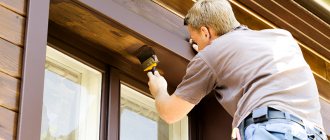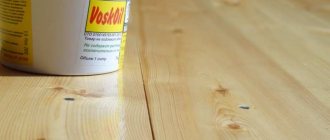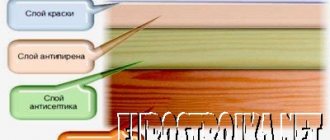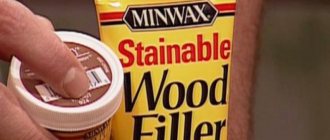Painting wood is an enjoyable and fairly simple task that even beginners can tackle. It's worse when choosing the right product. Which wood paint will work and protect the surface effectively? It's easy to get lost in the maze of names, terms and definitions.
Wood is an elegant material with a very wide range of uses. Due to its properties, competitive strength and resistance to a variety of factors, as well as undeniable aesthetic values, it is often used in interior decoration, construction, as the top layer of a facade or terrace or for the manufacture of small garden architecture elements and furniture.
Therefore, it is not afraid of “threats” arising from indoor use or exposure to adverse weather conditions. It is important not to skip the decisive step: protecting wooden surfaces. Without this, the wood will begin to deteriorate - you will notice fading and wear of the natural shade, as well as further scratches and cracks, which will soon turn into more and more serious damage. One wood protection method worth trying is paint. Which wood paint is best? What should you remember when purchasing?
How to choose paint for wood
To preserve the appearance of wood, you need to use high-quality paint. If you neglect this rule, the tree will be susceptible to fungus.
Pay attention to the following criteria:
- The paint should be uniform and not liquid.
- The content of natural ingredients will be a big plus when choosing paint. Since there will be no strong odor when painting wood.
- To prevent the possibility of fire, wood swelling or burning, the material must be resistant to these processes.
- For your convenience, take quick-drying paint, this will reduce your work time.
- High-quality paint is not subject to mechanical stress. Scratches and cracks will not be visible on it.
When purchasing paint, consumers focus on its appearance and composition.
Characteristics
Acrylic paint for wood adheres perfectly to the surface. It leaves no streaks or marks. The material helps preserve the structure of wooden products and has the characteristic of partial transparency. This allows you to design elements made of wood, thereby emphasizing the texture of the material. Acrylic has excellent breathability, which is of particular importance when decorating rooms.
There are many varieties of acrylic-based paints, but they all have standard characteristics:
| Material characteristics | Acrylic paint |
| Mass fraction of volatile substance in % ratio | No more than 52-57 |
| Consumption | 100-300 ml/m2 |
| Curing period | 2-4 hours |
| Temperature for application | From +5 to +20 degrees Celsius |
| Material Density | About 1.4 kg/dm3 |
| pH environment | From 7.5 to 9.5 |
| Frost resistance | More than 10 freeze and thaw cycles |
Types of paints for wood
Before purchasing, you need to understand what kind of work you are taking the material for. The paint can be used for interior or exterior decoration, for processing wooden furniture.
Alkyd
They are produced on the basis of pentaphthalic resins with the addition of special oils and solid fractions. Recently, this material has become increasingly popular due to its low cost. It protects the surface well from negative environmental influences, dries quickly, has good water-repellent properties and has an excellent decorative effect, as can be judged from numerous photos of coloring.
But it smells unpleasant and is flammable. It is a good alternative to oil paints and has a more diverse catalog of colors and shades.
Types of paint by appearance
Traditionally, paint for construction work is divided into three types based on appearance: opaque, transparent and dispersion.
- If we talk about opaque enamels, they perform an excellent protective function for wood.
- When using this type of paint, a hard layer is formed on the wood, protecting it from mechanical stress.
- They are used for processing wooden furniture, interior and exterior finishing works. They dry quickly, have virtually no odor, are durable and environmentally friendly.
Transparent coatings are characterized by resistance to moisture and light. Wood coated with this type of paint is not subject to rotting and aging. Most often, this paint is used to treat baths, interior decoration and furniture.
Dispersion paints have recently been gaining momentum among buyers. This popularity can be explained by the quality of this type of paint. When applied, the paint penetrates the wood, removing any remaining moisture in the material. Dispersion coatings repel water when it hits the surface, eliminating the aging process of wood.
Manufacturers
Both domestic and imported paints are in demand. Thanks to modern equipment and foreign experience, Russian manufacturers do not lag behind foreign ones. Everyone knows such brands as “Yaroslavskie Krasov”, “Drevoplast”, “Aquatex”, “Extra”. In each company you can find compositions for both external and internal work, as well as a rich palette of shades.
Along with Russian ones, foreign manufacturers of facade paints are also popular:
- "Pinotex ultra" (Estonia);
- "Belinka" (Slovenia);
- "Tikkurila Pika-Teho" (Finland);
- Dulux (UK);
- "DUFA" (Germany-Russia).
The most famous concern for the production of acrylic paints for exterior use is Tikkurila (Finland). Its products reliably protect wooden buildings from precipitation and also prevent the formation of mold and mildew. Acrylic paint "Tikkurila" is very resistant to fading in the sun. Repeated tests have shown that it provides maximum surface protection thanks to a three-layer system, which includes an antiseptic primer layer.
"DUFA" is also well known in Russia. These acrylic paints are made on modern equipment using the latest technologies, meet all safety requirements, and have a wide range of colors.
Acrylic paints are a universal material. They are suitable for both exterior and interior use, for wood, glass, concrete and any other surfaces, including plastic. Among the disadvantages, it is worth noting only low-quality production (typical of Chinese products) and violations in application technology (the result does not meet expectations). Otherwise, nothing better than acrylic paints has yet been invented.
Types of paints by composition
Depending on the location of painting, paint is selected. To paint the facade, a material that is moisture-resistant and light-resistant is used.
For painting inside the house, paint without a strong odor or toxins, which is breathable, is used. Such characteristics depend on the composition of the paint.
There are the following types of coatings by composition:
- Oily,
- Acrylic,
- Alkyd,
- Polyurethane.
Oil coatings
This paint is not very popular due to the unfavorable price-quality ratio. It is made from oil that has been subjected to a thermal reaction and colored pigments.
The only advantage of the paint is its protective function against the process of decay and aging of wood.
- The most important disadvantage is the price, since the production of paint is quite expensive.
- It has a pungent odor and is toxic, and fades quickly.
- Oil paints dry in about 12 hours and are highly susceptible to mechanical stress.
- It is difficult to work with and is characterized by the appearance of smudges, which are problematic to eliminate.
- Brushes are used to work with the oil structure.
This paint is usually used for painting fences and railings.
Acrylic coatings
One of the universal types of paint. It can be used for both internal and external finishing works.
- It is not subject to mechanical stress and is environmentally friendly. The paint has no pungent odor and is non-toxic.
- It tends to dry quickly, which is a nice bonus when you're short on time.
- Acrylic coating protects wood from exposure to light and moisture.
Before painting wood, its surface is sanded to make it smooth and then degreased. When applying to wood, you can use a roller and brushes. This composition is more convenient to use than oil.
Alkyd coatings
Alkyd coating is famous for its affordable price and tolerance to heat and cold. In addition, it helps protect the wood from pests and the aging process.
- This coating has a pungent odor that persists for 1.5 days after painting, so when working with an alkyd composition, respiratory protective agents are used.
- Alkyd paint is used for surfaces that are not subject to particular mechanical stress. These are doors, thresholds, window frames, and sometimes floors.
Polyurethane coating
Another option for expensive types of paint, but the price-quality ratio is completely justified. Such coatings are rarely found in homes or baths; they are used in hospitals, clinics or gyms.
It is easy to care for, it is not exposed to strong moisture, temperature changes, or mechanical damage.
Leading paint manufacturers
Everyone who works in this industry knows about the characteristics of this or that coating. Some make the material with high quality and conscientiously, while others use cheap analogues to create low-quality goods.
To eliminate the possibility of taking a bad product, people carried out various test drives of paints from different manufacturers.
Top 6 manufacturers you can trust:
- Belinka;
- Tikkurila;
- Alpina;
- Rogneda;
- Zobel;
- Neomid.
The rating considered various compositions, prices and purposes of use. There are good Russian paint manufacturers, for example, Senezh.
Before purchasing, take a closer look at different manufacturers, look at the compositions and methods of use.
Criterias of choice
Making the right choice is quite difficult, given the rich assortment of modern supermarkets.
Advice! Don't rush to go to the store. First, study all the important points, paying attention not only to the aesthetic side, but also to the practical one.
Acrylic paints are divided into 2 main categories:
- interior (for interior work);
- façade (for exterior).
The drying process of acrylic paint
Compositions for exterior use differ from interior ones in that they are more resistant to sunlight and various atmospheric influences. Typically, the façade is updated every 3–4 years. Therefore, you should not buy super expensive exterior paint with a long service life.
Read more about this in the material on façade paints for wood.
If painted surfaces are not supposed to be washed regularly with a brush or sponge, you should not choose compounds with a high abrasion rate. This will save you some money. If painting is done in a nursery or bedroom, give preference to hypoallergenic paints of a suitable color.
Criteria for choosing compositions for painting wood:
- Read the ingredients carefully. If it is long and unclear, refuse to purchase. The classic composition of acrylic paint is a filler (base), a binder (connects the paint components to each other, as well as to the surface), and a coloring pigment.
- Choose a product from a reputable manufacturer. If the inscription on the jar does not tell you anything, and the seller’s stories are not convincing, and he cannot show the certificate, refuse to buy.
- Check with the seller what properties the selected sample has (maximum protection against moisture and mold, rodents and insects).
- Estimate the paint consumption per 1 m2.
- Assess the performance capabilities of the future coating.
- Check the cost and calculate the financial costs of painting work.
How to apply paint to wood
If you decide to paint wood yourself, then you should purchase special tools. You will need brushes, a respirator, gloves, a spatula, a coating container, and a roller.
- The brush depends on the composition used.
- For a water base, synthetic bristles are used, for an oily base, natural bristles are used.
- The area of the brush pile is selected based on the surface being treated.
- You can save yourself some time and take a paint sprayer. But when using it, you definitely need a respirator.
Before using paint, the surface is always treated, all irregularities and roughness are removed.
Technology
The technological process takes place in stages and includes the following stages:
- Preparing tools.
- Surface treatment.
- Painting.
- Additional processing, if necessary.
The wood processing stage plays a significant role. If this procedure is performed correctly, no problems will arise in future operation.
Photo of odorless wood paint
Rubber
Manufactured using latex. It has many similarities with the previous version and even surpasses it in some ways. This material has ultra-high strength, is absolutely environmentally friendly, and has excellent vapor permeability, which makes it almost ideal for wood. However, the unjustified high cost of rubber paints slightly spoils the overall picture.
Requirements for paint and varnish coatings for facades
Which wood paint to choose for exterior work? When selecting, you must consider:
- Compound. No toxic compounds are used to produce these materials. The fact is that during the drying process they release a large volume of flexible compounds;
- Drying speed. Quality products dry within 5 hours after application. Each layer dries on average in 1-3 hours;
High performance. Conscientious manufacturers indicate the density of the paint layer, drying time and approximate service life. In addition, the instructions show favorable areas for the use of a particular composition.
Scope of application
This material can be used for painting interior surfaces: walls, ceilings, doors, frames, lining, various wood panels and so on. It can be used for finishing residential, commercial and public premises. Due to their efficiency and fire safety, acrylic paints are often used for decoration of hospitals, educational institutions and public catering establishments.
Acrylic compositions for wood are absolutely safe and can be used in any room, both for painting walls and for working with ceilings and furniture
What does the material consist of?
This finishing material refers to water-dispersed compositions that are made on the basis of methyl, butyl and ethyl polyacrylates, as well as their film-forming copolymers. In addition to the base, the following components are used:
- solvent – 30–40%;
- coloring pigment – 4–20%;
- filler (marble, chalk, talc) – about half;
- add-ons – no more than 4%;
- additional components (plasticizers, antiseptics, preservatives).
Acrylic resins are used as a binding polymer in acrylic paints.











